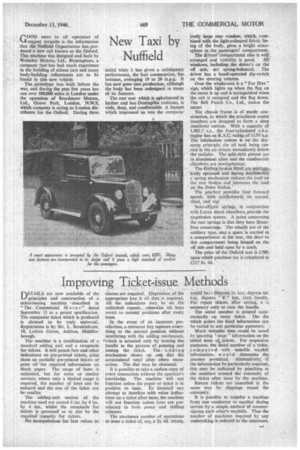Improving Ticket-issue Methods
Page 35

If you've noticed an error in this article please click here to report it so we can fix it.
DETA1LS are now available of the principles and construction of a ticket-issuing machine -described in "The Commercial M o tor" dated September 13 as a patent specification. The composite ticket which is produced is claimed to be truly universal. Registration is by Mr. L. Brocklehurst, 10, Lodore Grove, Acklam, Middlesbrough.
Tlic machine is a combination of a standard adding unit and a receptacle for tickets. It will punch fare and other indications on pre-printed tickets, print them on partially pre-printed tickets or print all' the required information Oct blank paper. The range of fares .is unlimited, but for town or similar services, where only a limited range is required, the number of keys can be reduced and the size of the ticket can be smaller.
The adding-unit section of the machine need not exceed 6 ins. by 4 ins. by 4 ins., whilst the receptacle for tickets is governed as to size by the required capacity for tickets.
No manipulations for fare values or classes are required. Depression of the appropriate key is all that is required. All the indications may. be set fin unlimited repeats,. otherwise all. keys revert to normal positions after every issue.
In the event of an incorrect preselection, a corrector key replaces everything to the normal position without interfering with the adding mechanism, 'which is actuated only by turning the handle in the process of printing and issuing the ticket. The adding mechanism shows on one dial the accumulated total after every transaction. The dial may be obscured.
It is possible to take a carbon copy of every transaction without the operator's knowledge. The machine will not function unless the paper or ticket is in position to issue. To forestall any attempt to interfere with value indications on a ticket after issue, the machine will not function unless keys are preselected in both pence and shilling columns.
The maximum number of operations to issue a ticket of, say, a 2s. 6d, return, would be:—Depress 2s. key, depress 6d. key, depress " R " key, turn handle. For repeat tickets, after setting, it fa. -necessary only to tarn the handle.
The serial number is printed automatically on every ticket. The die which prints the fixed information can be varied to suit particular operators.
Much valuable time could be saved by ignoring " stage " information on the initial issue at tickets. For inspection purposes, the serial number of a ticket, comp ared with suitable waybill information, would determine the
journey permitted. Alternatively', • if the information be particularly required, this may be indicated by punching in the numbers around the extremity of the ticket after issue by the machine.
Return tickets are cancelled in the same way by clippings round the extremity.
it is possible to transfer a machine from one conductor to another during service by a simple method of countersigning each other's waybills. Thus the number of machines required by any undertaking is reduced to the minimum,












































































